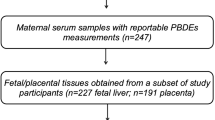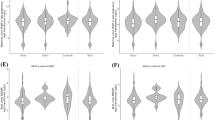Abstract
Higher concentrations of certain phthalate metabolites are associated with adverse reproductive and pregnancy outcomes, as well as poor infant/child health outcomes. In non-pregnant populations, phthalate metabolite concentrations vary by race/ethnicity. Few studies have documented racial/ethnic differences between phthalate metabolite concentrations at multiple time points across the full-course of pregnancy. The objective of the study was to characterize the change in phthalate metabolite concentrations by race/ethnicity across multiple pregnancy time points. Women were participants in a prospectively collected pregnancy cohort who delivered at term (≥37 weeks) and had available urinary phthalate metabolite concentrations for ≥3 time points across full-term pregnancies (n=350 women). We assessed urinary concentrations of eight phthalate metabolites that were log-transformed and specific gravity-adjusted. We evaluated the potential racial/ethnic differences in phthalate metabolite concentrations at baseline (median 10 weeks gestation) using ANOVA and across pregnancy using linear mixed models to calculate the percent change and 95% confidence intervals adjusted for sociodemographic and lifestyle factors. Almost 30% of the population were non-Hispanic black or Hispanic. With the exception of mono-(3-carboxypropyl) (MCPP) and di-ethylhexyl phthalate (DEHP) metabolites, baseline levels of phthalate metabolites were significantly higher in non-whites (P<0.05). When evaluating patterns by race/ethnicity, mono-ethyl phthalate (MEP) and MCPP had significant percent changes across pregnancy. MEP was higher in Hispanics at baseline and decreased in mid-pregnancy but increased in late pregnancy for non-Hispanic blacks. MCPP was substantially higher in non-Hispanic blacks at baseline but decreased later in pregnancy. Across pregnancy, non-Hispanic black and Hispanic women had higher concentrations of certain phthalate metabolites. These differences may have implications for racial/ethnic differences in adverse pregnancy and child health outcomes.
This is a preview of subscription content, access via your institution
Access options
Subscribe to this journal
Receive 6 print issues and online access
$259.00 per year
only $43.17 per issue
Buy this article
- Purchase on Springer Link
- Instant access to full article PDF
Prices may be subject to local taxes which are calculated during checkout

Similar content being viewed by others
References
Martinez-Arguelles DB, Campioli E, Culty M, Zirkin BR, Papadopoulos V . Fetal origin of endocrine dysfunction in the adult: the phthalate model. J Steroid Biochem Mol Biol 2013; 137: 5–17.
Martinez-Arguelles DB, McIntosh M, Rohlicek CV, Culty M, Zirkin BR, Papadopoulos V . Maternal in utero exposure to the endocrine disruptor di-(2-ethylhexyl) phthalate affects the blood pressure of adult male offspring. Toxicol Appl Pharmacol 2013; 266: 95–100.
Huang PC, Kuo PL, Chou YY, Lin SJ, Lee CC . Association between prenatal exposure to phthalates and the health of newborns. Environ Int 2009; 35: 14–20.
Ferguson KK, McElrath TF, Meeker JD . Environmental phthalate exposure and preterm birth. JAMA Pediatrics 2014; 168: 61–67.
Swan SH . Environmental phthalate exposure in relation to reproductive outcomes and other health endpoints in humans. Environ Res 2008; 108: 177–184.
Swan SH . Environmental phthalate exposure and the odds of preterm birth: an important contribution to environmental reproductive epidemiology. JAMA Pediatrics 2014; 168: 14–15.
Meeker JD, Ferguson KK . Urinary phthalate metabolites are associated with decreased serum testosterone in men, women, and children from NHANES 2011-2012. J Clin Endocrinol Metab 2014; 99: 4346–4352, jc20142555.
Hauser R, Calafat AM . Phthalates and human health. Occup Environ Med 2005; 62: 806–818.
Hurst CH, Waxman DJ . Activation of PPARalpha and PPARgamma by environmental phthalate monoesters. Toxicol Sci 2003; 74: 297–308.
James-Todd T, Stahlhut R, Meeker JD, Powell SG, Hauser R, Huang T et al. Urinary phthalate metabolite concentrations and diabetes among women in the National Health and Nutrition Examination Survey (NHANES) 2001-2008. Environ Health Perspect 2012; 120: 1307–1313.
Lind PM, Zethelius B, Lind L . Circulating levels of phthalate metabolites are associated with prevalent diabetes in the elderly. Diabetes Care 2012; 35: 1519–1524.
Svensson K, Hernandez-Ramirez RU, Burguete-Garcia A, Cebrian ME, Calafat AM, Needham LL et al. Phthalate exposure associated with self-reported diabetes among Mexican women. Environ Res 2011; 111: 792–796.
Buck Louis GM, Peterson CM, Chen Z, Croughan M, Sundaram R, Stanford J et al. Bisphenol A and phthalates and endometriosis: the Endometriosis: Natural History, Diagnosis and Outcomes Study. Fertil Steril 2013; 100: 162–169.e1-2.
Reddy BS, Rozati R, Reddy S, Kodampur S, Reddy P, Reddy R . High plasma concentrations of polychlorinated biphenyls and phthalate esters in women with endometriosis: a prospective case control study. Fertil Steril 2006; 85: 775–779.
Cobellis L, Latini G, De Felice C, Razzi S, Paris I, Ruggieri F et al. High plasma concentrations of di-(2-ethylhexyl)-phthalate in women with endometriosis. Hum Reprod 2003; 18: 1512–1515.
Weuve J, Hauser R, Calafat AM, Missmer SA, Wise LA . Association of exposure to phthalates with endometriosis and uterine leiomyomata: findings from NHANES, 1999-2004. Environ Health Perspect 2010; 118: 825–832.
Silva MJ, Barr DB, Reidy JA, Malek NA, Hodge CC, Caudill SP et al. Urinary levels of seven phthalate metabolites in the U.S. population from the National Health and Nutrition Examination Survey (NHANES) 1999-2000. Environ Health Perspect 2004; 112: 331–338.
Huang T, Saxena AR, Isganaitis E, James-Todd T . Gender and racial/ethnic differences in the associations of urinary phthalate metabolites with markers of diabetes risk: National Health and Nutrition Examination Survey 2001-2008. Environ Health 2014; 13: 6.
Meeker JD, Hu H, Cantonwine DE, Lamadrid-Figueroa H, Calafat AM, Ettinger AS et al. Urinary phthalate metabolites in relation to preterm birth in Mexico city. Environ Health Perspect 2009; 117: 1587–1592.
Zhao Y, Chen L, Li LX, Xie CM, Li D, Shi HJ et al. Gender-specific relationship between prenatal exposure to phthalates and intrauterine growth restriction. Pediatr Res 2014; 76: 401–408.
Just AC, Whyatt RM, Perzanowski MS, Calafat AM, Perera FP, Goldstein IF et al. Prenatal exposure to butylbenzyl phthalate and early eczema in an urban cohort. Environ Health Perspect 2012; 120: 1475–1480.
Engel SM, Miodovnik A, Canfield RL, Zhu C, Silva MJ, Calafat AM et al. Prenatal phthalate exposure is associated with childhood behavior and executive functioning. Environ Health Perspect 2010; 118: 565–571.
Engel SM, Zhu C, Berkowitz GS, Calafat AM, Silva MJ, Miodovnik A et al. Prenatal phthalate exposure and performance on the Neonatal Behavioral Assessment Scale in a multiethnic birth cohort. Neurotoxicology 2009; 30: 522–528.
Kobrosly RW, Evans S, Miodovnik A, Barrett ES, Thurston SW, Calafat AM et al. Prenatal phthalate exposures and neurobehavioral development scores in boys and girls at 6-10 years of age. Environ Health Perspect 2014; 122: 521–528.
Braun JM, Kalkbrenner AE, Calafat AM, Bernert JT, Ye X, Silva MJ et al. Variability and predictors of urinary bisphenol A concentrations during pregnancy. Environ Health Perspect 2011; 119: 131–137.
Adibi JJ, Whyatt RM, Williams PL, Calafat AM, Camann D, Herrick R et al. Characterization of phthalate exposure among pregnant women assessed by repeat air and urine samples. Environ Health Perspect 2008; 116: 467–473.
CDC (Centers for Disease Control and Prevention): Third National Report on Human Exposure to Environmental Chemicals. National Center for Environmental Health, Division of Laboratory Sciences: Atlanta, Georgia. NCEH Pub. No. 05-0570, 2005.
Hornung RW, Reed L . Estimation of average concentration in the presence of nondetectable values. Appl Occup Environ Hyg 1990; 5: 46–51.
Ferguson KK, McElrath TF, Ko YA, Mukherjee B, Meekr JD . Variability in urinary phthalate metabolite levels across pregnancy and sensitive windows of exposure for the risk of preterm birth. Environ Int 2014; 70: 118–124.
Boeniger MF, Lowry LK, Rosenberg J . Interpretation of urine results used to assess chemical exposure with emphasis on creatinine adjustments: a review. Am Ind Hyg Assoc J 1993; 54: 615–627.
Woodruff TJ, Zota AR, Schwartz JM . Environmental chemicals in pregnant women in the United States: NHANES 2003-2004. Environ Health Perspect 2011; 119: 878–885.
Zota AR, Calafat AM, Woodruff TJ . Temporal trends in phthalate exposures: findings from the National Health and Nutrition Examination Survey, 2001-2010. Environ Health Perspect 2014; 122: 235–241.
Braun JM, Just AC, Williams PL, Smith KW, Calafat AM, Hauser R . Personal care product use and urinary phthalate metabolite and paraben concentrations during pregnancy among women from a fertility clinic. J Expo Sci Environ Epidemiol 2013; 24: 459–466.
James-Todd T, Senie R, Terry MB . Racial/ethnic differences in hormonally-active hair product use: a plausible risk factor for health disparities. J Immigr Minority Health 2012; 14: 506–511.
Ananth CV, Demissie K, Kramer MS, Vintzileos AM . Small-for-gestational-age births among black and white women: temporal trends in the United States. Am J Public Health 2003; 93: 577–579.
Culhane JF, Goldenberg RL . Racial disparities in preterm birth. Semin Perinatol 2011; 35: 234–239.
Hauser R, Duty S, Godfrey-Bailey L, Calafat AM . Medications as a source of human exposure to phthalates. Environ Health Perspect 2004; 112: 751–753.
Acknowledgements
This research was funded by the Eunice Kennedy Shriver National Institute of Child Health and Human Development (K12HD051959) and The National Institute of Environmental Health Sciences (R01ES018872, P30ES017885).
Author information
Authors and Affiliations
Corresponding author
Ethics declarations
Competing interests
The authors declare no conflict of interest.
Additional information
Supplementary Information accompanies the paper on the Journal of Exposure Science and Environmental Epidemiology website
Supplementary information
Rights and permissions
About this article
Cite this article
James-Todd, T., Meeker, J., Huang, T. et al. Racial and ethnic variations in phthalate metabolite concentration changes across full-term pregnancies. J Expo Sci Environ Epidemiol 27, 160–166 (2017). https://doi.org/10.1038/jes.2016.2
Received:
Accepted:
Published:
Issue Date:
DOI: https://doi.org/10.1038/jes.2016.2



